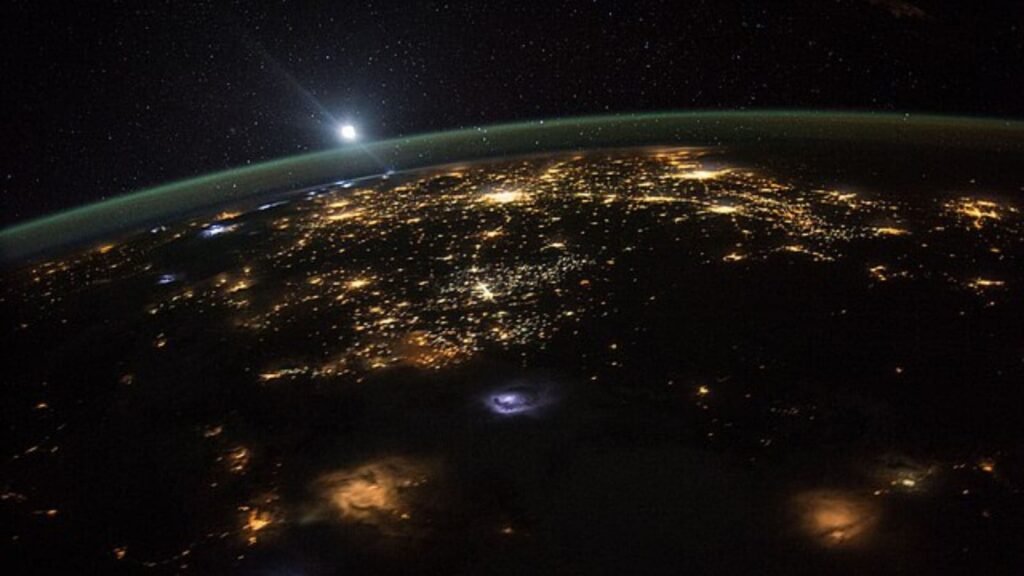Since the advent of space exploration, cameras have been silent companions on nearly every mission, capturing some of the most extraordinary sights ever witnessed.
With the advancement of technology, high-performance cameras are being designed to be increasingly ultra-lightweight for space where every gram counts. However, the pursuit of bettering the quality remains uncompromised to illuminate distant worlds in stunning detail through the lenses of astronauts, robotic explorers, and powerful telescopes.
As India established a step ahead in its space program, with Shubhanshu Shukla at the International Space Station (ISS) as part of the Axiom-4 mission, we take a look at the top 10 most iconic space photographs ever clicked.
1. Apollo 8 ‘Earthrise’ (1968)
On Christmas Eve 1968, Apollo 8 astronaut William Anders captured the first colour photograph of Earth rising above the lunar horizon. The blue-and-white sphere of Earth, set against the stark gray of the Moon, was taken during humanity’s first journey around the Moon.
 The Earth as seen from the moon. (Photo via NASA)
The Earth as seen from the moon. (Photo via NASA)
2. Apollo 17 ‘Blue Marble’ (1972)
The “Blue Marble” was taken by the Apollo 17 crew en route to the Moon, showing a fully illuminated Earth. Captured with a hand-held Hasselblad camera, it reveals Africa, Antarctica, and the swirling clouds of our atmosphere.
 The image was captured with a handheld camera. (Photo via Wikimedia Commons)
The image was captured with a handheld camera. (Photo via Wikimedia Commons)
3. Apollo 11: Buzz Aldrin on the Moon (1969)
During the first Moon landing, Neil Armstrong photographed Buzz Aldrin standing on the lunar surface, with Armstrong and the lunar module reflected in Aldrin’s visor. This image captures the achievement of the Apollo program.
 Photo taken by Neil Armstrong (via Wikimedia Commons)
Photo taken by Neil Armstrong (via Wikimedia Commons)
4. Mars Pathfinder: Sojourner on Mars (1997)
NASA’s Mars Pathfinder mission delivered the Sojourner rover to the surface of Mars, where it sent back images of the Martian terrain and itself exploring the rocky landscape. These photos marked the first time a rover operated on another planet.
Story continues below this ad
 The Martian terrain (Photo via NASA)
The Martian terrain (Photo via NASA)
5. Mars Curiosity rover selfie (2012)
The Curiosity rover has sent back several self-portraits from Mars, stitched together from images taken by its robotic arm.
 One of the self-portraits by the rover. (Photo via Wikimedia Commons)
One of the self-portraits by the rover. (Photo via Wikimedia Commons)
6. Voyager 1 “Pale Blue Dot” (1990)
As Voyager 1 left the solar system, it turned its camera back toward Earth and captured our planet as a tiny dot suspended in a sunbeam. This image was made famous by Carl Sagan.
 the Earth can be seen as a diny dot in the centre of the light beam. (Photo via Wikimedia Commons)
the Earth can be seen as a diny dot in the centre of the light beam. (Photo via Wikimedia Commons)
7. Saturn from Cassini: ‘The Day the Earth Smiled’ (2013)
On July 19, 2013, as NASA’s Cassini spacecraft captured a mosaic of Saturn, its rings, and several moons, it also photographed Earth as a tiny blue dot nearly 900 million miles away. Planetary scientist Carolyn Porco, who led the imaging team, encouraged people around the world to reflect on their place in the cosmos and to step outside and “smile” as their photo was being taken from deep space.
 This photo was captured by NASA’s Cassini spacecraft. (Photo via Wikimedia Commons)
This photo was captured by NASA’s Cassini spacecraft. (Photo via Wikimedia Commons)
8. Hubble’s first light image (1990)
Shortly after its launch, the Hubble Space Telescope captured its “first light” image. Though not as visually stunning as later Hubble images, this photograph demonstrated the telescope’s power and set the stage for decades of discovery.
Story continues below this ad
 The photo demonstrated the telescope’s power. (Photo via Wikimedia Commons)
The photo demonstrated the telescope’s power. (Photo via Wikimedia Commons)
9. Hubble’s view of Jupiter and Europa (2020)
Hubble’s high-resolution image of Jupiter and its moon Europa reveals intricate details of the planet’s atmosphere and the icy surface of its moon.
 The tiny dot seen in the image is Europa, Jupier’s moon. (Photo via Wikimedia Commons)
The tiny dot seen in the image is Europa, Jupier’s moon. (Photo via Wikimedia Commons)
10. Hubble’s portrait of the galaxy NGC 4449
This Hubble image shows the irregular galaxy NGC 4449, a star-forming galaxy in the constellation Canes Venatici.
 NGC 4449 belongs to the constellation Canes Venatici. (Photo via Wikimedia Commons)
NGC 4449 belongs to the constellation Canes Venatici. (Photo via Wikimedia Commons)
(With inputs from Space, NASA, ESA, BBC)
© IE Online Media Services Pvt Ltd



